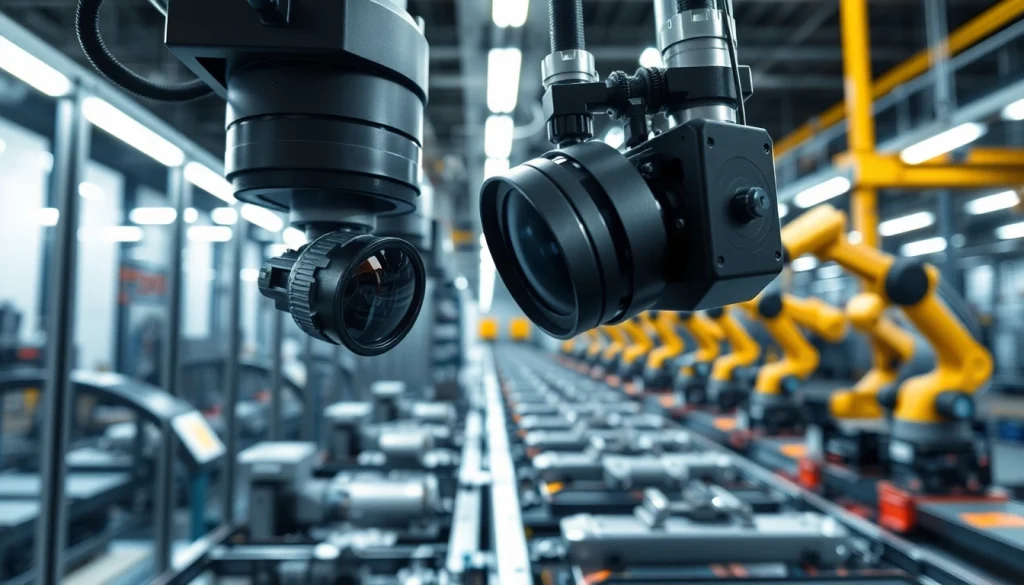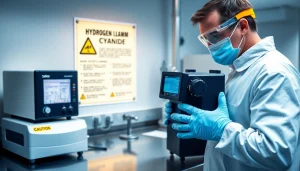Understanding Machine Vision: Applications, Technologies, and Future Trends

What is Machine Vision?
Machine vision is a powerful technology that employs imaging systems such as cameras and software algorithms to automate visual inspection and analysis processes in various industries. Beyond mere image capture, it enables machines to interpret visual data akin to human vision. In essence, machine vision creates intelligent inspection systems capable of enhancing productivity and ensuring quality assurance in manufacturing and process automation.
Definition and Concepts
At its core, machine vision refers to the technology that allows computers to process, analyze, and interpret visual information. This process typically involves several steps: image acquisition, data processing, and decision-making based on the input data. Machine vision systems are equipped with various types of cameras and sensors that capture images of objects in real-time, which are then analyzed using sophisticated software methods to extract useful information, determine operational effectiveness, and detect anomalies or defects.
The Role of Cameras and Sensors
Cameras and sensors are fundamental components of machine vision systems. They not only capture visual images but also convert them into digital data that can be processed by specialized software. Different types of cameras are utilized depending on the specific requirements of the application, such as:
- 2D Cameras: Ideal for basic inspection tasks like surface evaluation and position alignment.
- 3D Cameras: Used for depth perception applications, enhancing the ability to detect gaps, heights, and contours of objects.
- Infrared Cameras: Useful for temperature measurements and detecting faults in electrical components.
Sensors complement cameras by providing critical information about environmental conditions such as lighting and angle, which significantly influence image quality. The integration of these devices is essential for high precision and reliability in machine vision applications.
Machine Vision vs. Computer Vision
While frequently used interchangeably, machine vision and computer vision represent distinct paradigms. Machine vision primarily focuses on industrial applications, aiming at automated inspection and quality control of the manufacturing process. In contrast, computer vision encompasses a broader field that includes various algorithms and applications—such as facial recognition and autonomous vehicle navigation—analyzing images and visual data beyond the confines of industrial settings. Understanding this difference helps organizations choose the right system for their specific needs.
Key Applications of Machine Vision
Quality Control and Defect Detection
One of the most significant applications of machine vision is in quality control and defect detection. By automating the inspection process, machine vision systems can conduct high-speed real-time evaluations of products, identifying defects that are often too subtle for human inspectors to detect. For instance, in the automotive industry, machine vision systems are employed to inspect welds and coatings, ensuring that every component meets strict quality standards. Techniques such as pattern recognition, edge detection, and color analysis are commonly used in these processes to ensure accuracy and reliability.
Automation in Manufacturing
Machine vision facilitates the integration of automation across a wide range of manufacturing processes. Whether it’s guiding robotic arms in assembly lines or ensuring parts are correctly placed and aligned, machine vision systems contribute to more efficient workflows. For example, in electronics manufacturing, machine vision systems can identify the correct placement of microchips on circuit boards, contributing to higher first-pass yields and reducing rework costs.
Logistics and Inventory Management
In logistics, machine vision plays a crucial role in automating inventory management, tracking products as they move through the supply chain. Systems can scan barcodes or QR codes, log products in real-time, and assess inventory levels accurately. Implementing machine vision technology can significantly reduce human error while improving accuracy and process efficiency, which is vital in sectors such as warehousing and distribution. Retail environments utilize machine vision for managing stock levels and minimizing waste, ensuring that consumers have access to the products they need.
Technologies Behind Machine Vision
Hardware Components
The hardware in machine vision systems typically includes cameras, lenses, lighting, and processing hardware. Each component plays a vital role in forming a complete vision system. For example, lighting conditions greatly affect image clarity; hence, systems often utilize LED and backlighting to illuminate objects uniformly, which enhances image contrast and detail. The choice of lenses—whether telephoto, macro, or wide-angle—determines the field of view and depth of the scene being captured.
Software Algorithms
Advanced software algorithms are at the heart of machine vision systems. These algorithms process images to extract relevant information. Techniques include:
- Image Segmentation: This process involves dividing an image into multiple segments to simplify analysis.
- Pattern Recognition: Used to identify specific arrangements of pixels that correspond to known features or objects.
- Machine Learning: Algorithms that improve their performance based on learning from new data inputs, allowing machine vision systems to adapt over time.
By leveraging these sophisticated algorithms, machine vision can provide insights that improve operational efficiencies and product quality.
Integration with AI and Machine Learning
The integration of artificial intelligence (AI) and machine learning (ML) into machine vision marks a transformative advancement in the field. AI technologies can enhance traditional machine vision capabilities by analyzing large datasets from visual inspections and identifying patterns that a human might miss. For example, by employing AI in defect detection, systems can learn from previous inspections, constantly improving their detection accuracy over time. This synergy not only optimizes the manufacturing processes but also leads to innovations in predictive maintenance and quality assurance strategies.
Challenges in Implementing Machine Vision
Cost and ROI Considerations
While the benefits of machine vision are substantial, implementing such systems can entail significant costs, raising concerns about return on investment (ROI). Businesses must consider the expenses related to hardware, software, training personnel, and maintaining the equipment. To assess ROI thoroughly, companies should evaluate the potential gains in efficiency, accuracy, and production speed against the initial investment. Conducting pilot tests can provide insights into the viability of the investment before full-scale implementation.
Technical and Environmental Constraints
Various technical challenges can hinder the successful deployment of machine vision systems. Factors such as illumination conditions, object variability, and environmental noise can affect image quality and therefore the accuracy of defect detection and analysis. Organizations must ensure that systems are robust enough to handle variations in production environments, including fluctuations in temperature, humidity, and lighting. Regular calibration and maintenance of equipment can mitigate some of these issues, maintaining the system’s performance over time.
Data Management and Security
As machine vision systems generate large volumes of data, effective data management becomes critical. Companies must have robust data storage solutions and analytical tools to manage and interpret the insights gained from visual inspections. Along with data management, security considerations are also paramount, particularly in industries like automotive and healthcare where sensitive information may be processed. Implementing stringent cybersecurity measures must go hand-in-hand with machine vision deployments to safeguard against unauthorized access and data breaches.
Future Trends in Machine Vision
Advancements in Imaging Technology
Future advancements in imaging technology will significantly enhance the capabilities of machine vision systems. Emerging trends include hyperspectral imaging, which provides detailed spectral information about objects beyond visible light, and 3D imaging technologies that will improve the depth perception of systems. The advent of higher resolution cameras and faster image processing technologies will allow more complex inspections and analyses, further pushing the boundaries of what machine vision can achieve.
Impact of AI on Machine Vision
The impact of AI on machine vision will likely intensify as algorithms continue to evolve. Expect machine vision systems to not only detect defects but also make data-driven decisions autonomously, leading to improved manufacturing agility and responsiveness. The increased adoption of deep learning methodologies will facilitate more comprehensive image analysis, enabling systems to identify imperfections that fall outside traditional defect categories. Consequently, AI’s role in interpreting machine vision data will play a pivotal role in the future of automation.
Potential for Industry 4.0 Integration
As industries transition towards Industry 4.0, machine vision technologies will be integral to this revolution. The convergence of machine vision with IoT (Internet of Things) enables real-time data sharing across devices, enhancing operational transparency and control. Integrating machine vision systems into smart factories will lead to more interconnected production processes, optimizing supply chains and improving overall efficiency. This holistic approach to automation and data analytics will open doors to innovative business models and new opportunities across various sectors.







